This review page is supported in part by the sponsors whose ad banners are displayed below |
 |
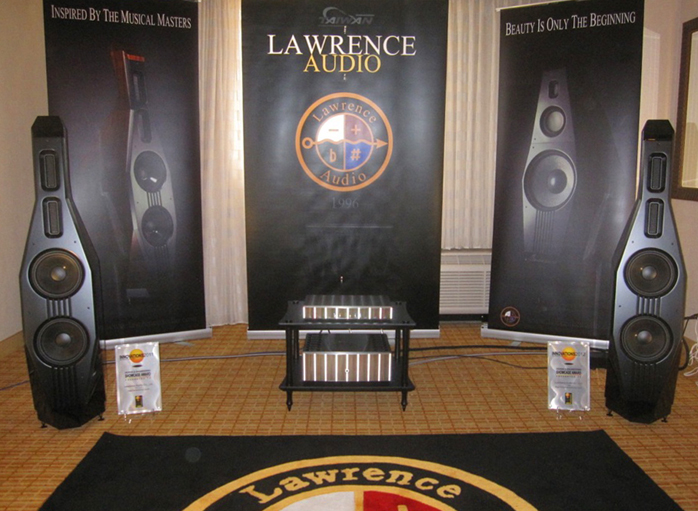 |
Lawrence Audio. This room really took me by surprise. The speakers are designed by Lawrence Liao in Taiwan, hence Lawrence Audio. Their appearance is quite distinctive and here looked somewhat like a slim upright bass. This was no coincidence as the model was actually called the Cello. There was an AMT air motion transformer midrange and tweeter, two woofers and a ribbon tweeter on the back. There was a sense of very low distortion from this speaker as well as exemplary tonal balance and good dynamics. At $18.000/pr I think this competes well with anything near its price and would be near the top of my audition list if I used solid-state amplifiers.
|
 |
Rockport, Playback Designs, Balanced Audio Technology, The Sound Environment, Transparent Audio Inc. The Rockport Avior speakers powered by a BAT VK655SE amp sounded very smooth throughout the frequency range. However when playing Damien Rice’s Blower’s Daughter (which I own at home), I felt that the vocal was fuller and the soundstage bigger in my own system. I was really perplexed since I’ve never heard a demo of a Rockport speaker that didn’t impress me greatly. In fact a demo of the Rockport Hyperion with Tenor amps many years ago at a CES is still one of the top systems I ever heard. I’m chalking this up to some missing component synergy or a room acoustics issue.
|
 |
Xact Audio – Schröder tone arms, Allnic, Lyra, Zu Audio, Kodo The Beat. In my opinion the new Schröder pivoted tangentially tracking tone arm was the star of this room. The Punch Brothers played and the sound was just delightful. I voted the Schroder tone arm as the best technological innovation last year and seeing/hearing it again made my juices flow even more. I just may have to get one. Michael Fremer wedged himself into the crowd around the turntable while Steve Dobbins was giving a closeup demo of the arm so I’m sure it will be passing under his watchful eye soon enough.
|
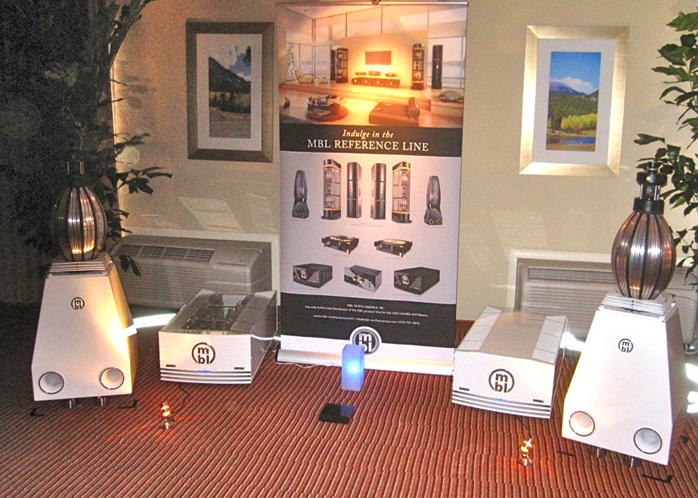 |
MBL North America. Jeremy Bryan, president of MBL North America, must be credited with some of the most consistently excellent sound at every show. Nothing seems to be left to chance - careful speaker placement of course, tastefully selected music tracks and even some of the most comfortable seating. The only drawback is that you cannot request your own music since it's all computer playback. The MBL 101E MkII played the main room and the MBL 120 monitors a side room. Both put a smile on my face and made me want to sit and relax - which many were doing. Still the sound quality achieved by the smaller system in some ways was even more impressive given its relatively more affordable price.
|
 |
Sounds Real Audio – Wilson Benesch, Bricasti Design Ltc., Zesto Audio, deHavilland Electric Amplifier Co. The Wilson Benesch Curve speakers had some of the best midrange-and-up performance of the show. Loreena McKennitt’s soprano voice sounded better than I ever heard it. Many systems give her voice a hardness or thinness but not this one. However Dean played his Mickey Hart Planet Drum CD and the bass impact was not up to the same standards.
|
 |
|
|
|
German Physiks. Prior to the show I got an email from a gentleman who was in the German Physiks room last year saying he hoped I'd find the sound improved this time. I ran into him in the hall and we shared a laugh. It is refreshing to find someone who takes criticism without getting angry. He invited me in and prepped me by saying that the speakers had very few hours on them and that their bass was not fully developed yet. If the bass did flesh out then I would certainly find the sound quite satisfying. Unfortunately I was unable to find the time to stop back later.
Antelope Audio, KR Audio. Thanks to these gentlemen for putting on a demo of A/D conversion of vinyl. Admittedly the Technics SL-1200 turntable with Audio Technica cartridge rig left much to be desired but the comparison of the digitized file and original vinyl was valid. I still preferred the vinyl but the digital file was not embarrassed. Recently I converted an LP in my system to DSD using the Korg MR-2000S. It got me about 75% there but the original vinyl still had a more organic quality as well as more air and bloom. The digital file also collapsed the soundstage somewhat.
|
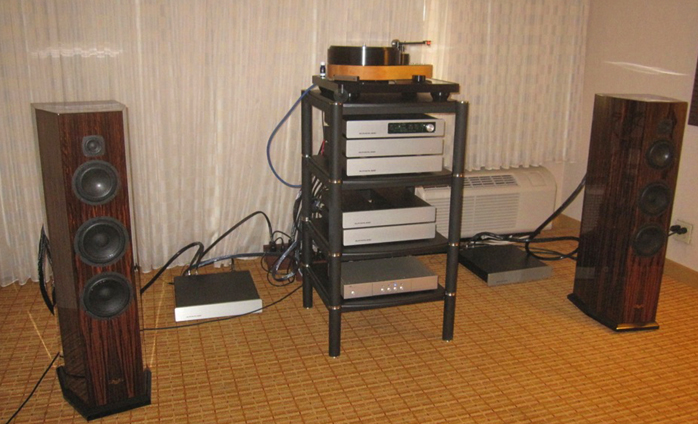 |
Sutherland Engineering, Venture, EnKlein Systems, AMG. Ron Sutherland himself manned this room. He was most gracious and asked what I would like to hear. I requested a Benny Carter LP which sounded very clean with low background noise and excellent tonal balance, all hallmarks of his electronics. Yet this tube lover yearned for a bit more warmth.
|
 |
Von Schweikert Audio, Light Harmonic, MIT cables. For starters this was a visually stunning room. I believe the space-age pulsing light chassis for the Light Harmonic Da Vinci DAC was specially built for the show. A Mac Mini source joined the Da Vinci with its 32-bit 384kHz oversampling, 3 clocks and no digital filtering. There is an interesting thread on the What’s Best Forum about this DAC and the high-frequency droop that occurs with Redbook playback. Johnny Cash played when I entered followed by Keith Greeninger’s "Looking for a Home". Both sounded clean and natural. An LP transfer to 24/192 of a Three Blind Mice jazz recording (some of which I own) captured the delicacy of the piano well. Before parting the host played the workhorse 1812 Overture (HD Tracks, 24/176) and the cannon shots came through with as little distortion as I ever heard. Upon exiting the room my listening buddies felt there was some harshness on this cut but how many systems can play it without losing some control? Personally I felt it did a yeoman’s job of it.
|
 |
Emerald Physics, Spatial Computer LLC, Underwood HiFi. The demo here did not seem much different than last year's. The strong selling point being made was of a $6.000 complete bi-amped system that really does deliver the goods. For those who don't want to fuss with trying to decide which components to match, this really is a great turnkey solution. On the Dire Straits "I Want My MTV" there was a little edginess to the guitar but overall this system had some major strengths, one of them that it will play very loud while maintaining tonal balance. The host said the tweeter would play to 140dB. Cough!
|
 |
Bricasti Design, Kimber Kable, Harbeth, D’Agostino, Parasound. The featured component here was the Bricasti Design M1 DAC with its user-selectable digital filtering. Harbeth speakers, Parasound transport, computer files, Dan D’Agostino amp and Kimber cables rounded out the system. I found filter number two most to my liking on the music played but overall I would have preferred more warmth and bloom from the system.
|
|
|
|
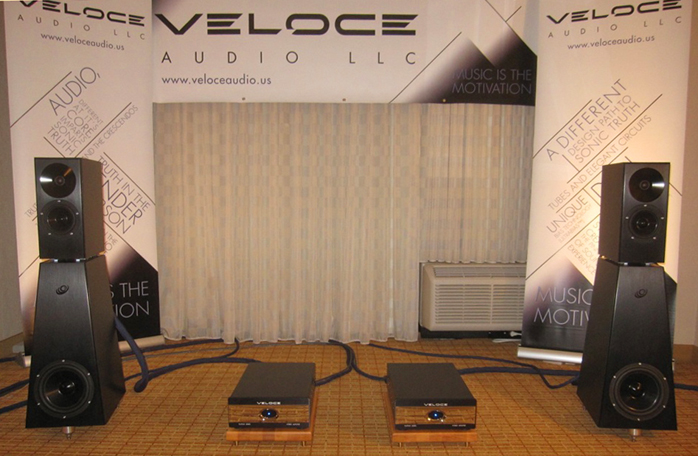 |
YG Acoustic, Veloce Audio, Kubala Sosna, PS Audio. At various shows I heard some of the best sound from both the YG Acoustic Carmel and Kipod speakers. This room used the Kipod. Rimsky-Korsakov’s "The Dance of the Tumblers" played when I entered and it was very spacious with excellent tone. On Jane Monheit’s "Over the Rainbow" there was a tremendous sense of blackness to the background and her voice was finely focused and nuanced. The battery-powered Veloce electronics surely had quite a lot to do with that and it seems that this lasting show partnership of YG/Veloce is a successful one.
|
 |
Ayre Acoustics, Vivid. This was a really cool room because it also featured vintage interior decorating right up my alley. There was a bevy of Ayre electronics facilitating LP playback. The music selection was also some of my favorite, with Gene Ammons Bluesville and Jimmy Smith’s Back At The Chicken Shack (my favorite album from him) playing. On the latter the sax and organ were just great, with all of the meatiness and verve that Jimmy brings to this performance.
|
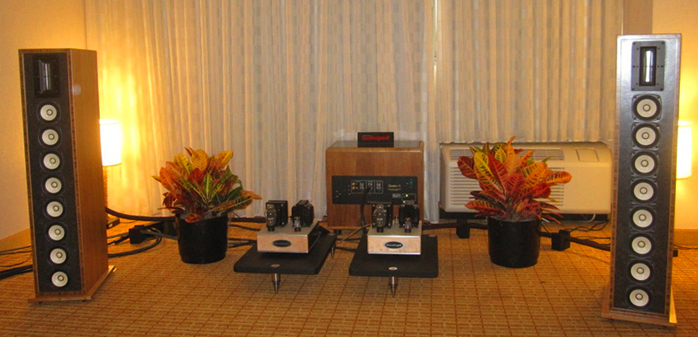 |
Wavelength Audio Ltd., Vaughn Loudspeakers, REL. The Wavelength Cardinal 300B tube monos were paired with the Wavelength 71A tube preamp, Crimson DAC and top-line Vaughn Cabernet II speakers to produce a warm and lively sound that was one of my favorites. Again we heard "The Dance of the Tumblers" and it was extremely transparent throughout the range, giving a clear view into the hall. Also noteworthy was lack of congestion on dynamic peaks. On other music selections a clarinet was silky and reedy with a seductive quality. Piano was harmonically rich with crisp attack. I didn’t hear one thing here that bothered me. A REL Stentor II subwoofer came in at a very low 24Hz.
|
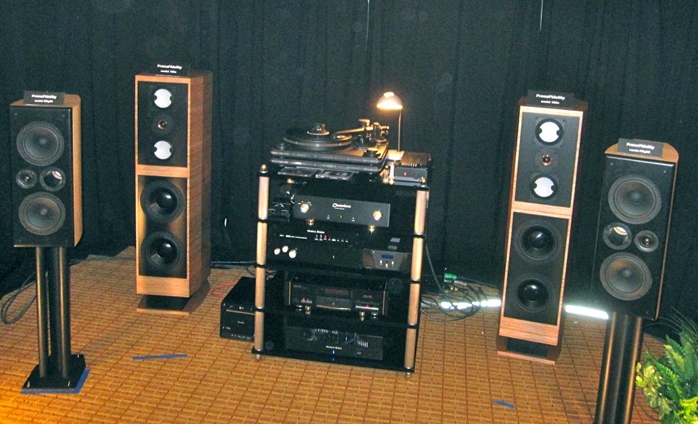 |
PranaFidelity, Musical Concepts/Musical Design. Steven Norber, President of PranaFidelity, is a down-to-earth no nonsense guy who puts on a great demo which is paired with the veteran skills of John Hillig from Musical Concepts. Steven injects some refreshing humor and lightness at times which adds to his charm. The bookshelf-sized PranaFidelity model fifty90 speakers at $3.500/pr produced very coherent natural sound. The tweeter blended seamlessly with the dual woofers. Associated electronics were very affordable including the Musical Design Chameleon integrated amp, a Pioneer PD-75 CD player used as transport, Wyred4Sound DAC ($1500 model) and purposely non-exotic Belden cables. I added this room to my best of show list.
|
 |
  |
 |